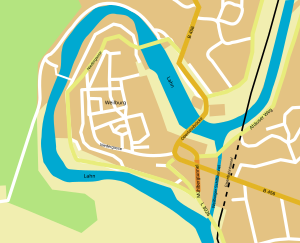Weilburg suburb bypass
The Weilburg suburban bypass involves relocating the federal highway 456 in Weilburg in the Limburg-Weilburg district in Hesse .
history
planning
Until the construction of the suburban bypass, first the federal highway 49 , later the federal highway 456, runs over the stone bridge from 1768 and through the narrow inner city, in order to then leave it through the country gate .
In 1964 the district building authority proposed the construction of a bypass for the first time . This is a large-scale bypass. The planning of a large-scale bypass was rejected in 1979, however, as it would have brought only 30% relief, while a suburban bypass suggested a reduction of 75%.
From the 1970s onwards, planning therefore concentrated on an inner-city expansion. Planning is always caught between the difficult geographic conditions, monument protection and nature conservation . A traffic census in 1972 counted 11,000 vehicles on the Steinerne Brücke. In 1978, plans for the first time provide for a bridge between Landtor and Bahnhofsstraße. Several variants are designed for this process. In 1988, variant G finally prevailed. According to a report by Kurt Ackermann , the bridge was designed as an arch bridge.
A traffic census in 1992 counted 17,300 vehicles on the Steinerne Brücke.
On October 11, 1992, the current plans based on the G variant are presented to the public. The Weilburg city parliament unanimously approves this. The planning approval procedure begins on August 31, 1995 . This was successfully concluded with the signing of the planning approval decision on August 23, 1999. On November 4, 1999, the planning approval decision becomes legally binding. No lawsuits were filed.
Construction work
With the clearing of the route on January 11, 2000, the first preparatory work was done. The groundbreaking ceremony took place on October 27, 2000 near the Weilburg indoor swimming pool. The construction time was estimated at four years.
Some residential buildings and a petrol station had to be demolished for the construction project, and this was partly done in advance of the project.
The soil conditions in the area of the Lahn valley were a particular structural challenge due to the alternation of layers of clay with diabase .
The construction costs amounted to around 28 million euros. They were mainly borne by the Federal Republic of Germany .
The official opening of the Weilburg suburban bypass will take place on December 22nd, 2004 by the Hessian Transport Minister Alois Rhiel and State Secretary Alfred Hartenbach .
Participating companies
The most important construction lots were carried out by the following companies:
- Civil engineering : Schnorpfeil GmbH, Treis-Karden
- Tunnel construction: Schachtbau Nordhausen GmbH, Nordhausen
- Road construction in the connection areas: Jost GmbH & Co KG from Weilmünster
Special structures
Oberlahn Bridge
The Oberlahnbrücke is the bridge over the Lahn . It begins on the Westerwald side as a curved foreland bridge, which is followed by the 54 m long arched structure that ends on the Taunus side . The total length is 145 meters. The Oberlahnbrücke is the core of the entire suburb bypass. It is an elevated reinforced concrete bridge as an arch bridge . This crosses the Lahn at a height of 12 meters. The superstructure rests every 10.80 meters on a column with a diameter of 0.60 meters. The bridge is an integral bridge structure in which the superstructure and substructure are monolithically connected. The thickness of the arch is 0.90 meters. The total width of the bridge is 14.5 meters. The two continuous lanes are each 3.75 meters wide, the continuous turning lane 3 meters, the walkway on each side is 2 meters wide. The road rises in the direction of Taunus with a gradient of 2.9%, the cross slope fluctuates between 1.2% and 4%.
Mühlberg tunnel
The Mühlberg tunnel is a tunnel under Frankfurter Strasse to connect Weilstrasse to the new bypass. Parallel to the Mühlberg tunnel, a rail tunnel and a shipping tunnel also cross Frankfurter Strasse.
The tunnel stop for the Mühlberg tunnel was on August 5, 2002, the breakthrough on February 10, 2003. On March 3, 2004, the tunnel was opened to traffic by the Hessian Transport Minister Alois Rhiel . The construction costs of the tunnel amounted to 3.9 million euros.
The tunnel is 132 meters long, around 120 meters of which were built using mining techniques. The two lanes are each 3.75 meters wide.
Parking garage
In the course of bypassing the suburb, a two-storey car park with 200 parking spaces was also built at the Landtor . The parking decks are open to the Lahn. When the Lahn floods, the lower level can be closed and used as a retention area. The construction costs of the parking garage amounted to almost 2.5 million euros.
literature
The bridge . Special supplement to the Weilburger Tageblatt , December 22, 2004
Web links
Coordinates: 50 ° 29 ′ 2.6 ″ N , 8 ° 15 ′ 51.3 ″ E





